Back to the Index page
Trip to Sleightholmedale June 19th 2010
notes by Gill Smith [Species lists below]
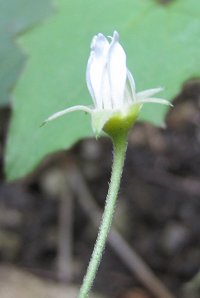 A dozen members attended this very interesting meeting in Sleightholmedale which was led by Mrs Rosanna James from Sleightholmedale Lodge. Unfortunately the weather was not kind – it was cool and windy with showers, much more like April than mid-June! We met at the end of the Avenue, walked down through the woods and then back through the meadows. Rosanna set the scene for us by explaining that when she lived here as a child she and her sister used to go exploring in the woods and fields, and became fascinated by the wealth of wildflowers growing there. This is an area of ancient woodland on steep slopes cutting through bands of limestone and some sandstone, giving a great variety of soils and therefore niches for different plants. There are several unusual plants in these woods, such as columbine and stone bramble (see detail of flower left). In the flat valley bottom is an area of old meadows that are lightly grazed by cattle, a form of management that has not changed in several hundred years. In 1986 some 80 acres of this valuable habitat was made into an SSSI, including the meadows and some of the woodland. On the west bank of the river is a heronry.
A dozen members attended this very interesting meeting in Sleightholmedale which was led by Mrs Rosanna James from Sleightholmedale Lodge. Unfortunately the weather was not kind – it was cool and windy with showers, much more like April than mid-June! We met at the end of the Avenue, walked down through the woods and then back through the meadows. Rosanna set the scene for us by explaining that when she lived here as a child she and her sister used to go exploring in the woods and fields, and became fascinated by the wealth of wildflowers growing there. This is an area of ancient woodland on steep slopes cutting through bands of limestone and some sandstone, giving a great variety of soils and therefore niches for different plants. There are several unusual plants in these woods, such as columbine and stone bramble (see detail of flower left). In the flat valley bottom is an area of old meadows that are lightly grazed by cattle, a form of management that has not changed in several hundred years. In 1986 some 80 acres of this valuable habitat was made into an SSSI, including the meadows and some of the woodland. On the west bank of the river is a heronry.
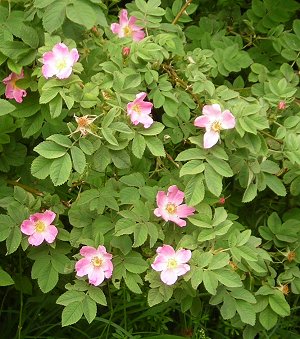 Along the track there are numerous wild roses, including this – one of the Rosa mollis group, with deep pink flowers, bluish foliage, thin straight prickles and numerous glandular hairs on the sepals. Just by the gate from the meadow back into the woods there is a run of fine old lime trees (the native species Tilia cordata with relatively delicate foliage and the flower clusters held above the leaves). Along this stretch of path Rosanna remembers there used to be a few plants of wintergreen Pyrola minor. Several of us searched the woods quite thoroughly but sadly failed to find it. Pauline is familiar with this species and reckons it would be easier to spot in late autumn or winter when other plants have died down – as its name suggests Pyrola remains green and therefore stands out against the brown of dead leaves – so it is probably worth another search later in the year. It would certainly be great to find this unusual plant still growing here on one of its known old sites. We did find both columbine and lily of the valley (leaves only, the flowers had finished), but the highlight for many of us was a good colony of stone bramble. This is a small relative of blackberries and raspberries that grows on steep rocky slopes, in or near old woods, at least here in Ryedale. It is difficult to identify unless it is in flower or fruit: here you can see the characteristic flowers with small, narrow, pure white petals standing upright from the five sepals that open out into a 5-pointed star as the flowers fade. The fruits, which don’t form very often, are red and shiny, with fewer segments than a bramble.
Along the track there are numerous wild roses, including this – one of the Rosa mollis group, with deep pink flowers, bluish foliage, thin straight prickles and numerous glandular hairs on the sepals. Just by the gate from the meadow back into the woods there is a run of fine old lime trees (the native species Tilia cordata with relatively delicate foliage and the flower clusters held above the leaves). Along this stretch of path Rosanna remembers there used to be a few plants of wintergreen Pyrola minor. Several of us searched the woods quite thoroughly but sadly failed to find it. Pauline is familiar with this species and reckons it would be easier to spot in late autumn or winter when other plants have died down – as its name suggests Pyrola remains green and therefore stands out against the brown of dead leaves – so it is probably worth another search later in the year. It would certainly be great to find this unusual plant still growing here on one of its known old sites. We did find both columbine and lily of the valley (leaves only, the flowers had finished), but the highlight for many of us was a good colony of stone bramble. This is a small relative of blackberries and raspberries that grows on steep rocky slopes, in or near old woods, at least here in Ryedale. It is difficult to identify unless it is in flower or fruit: here you can see the characteristic flowers with small, narrow, pure white petals standing upright from the five sepals that open out into a 5-pointed star as the flowers fade. The fruits, which don’t form very often, are red and shiny, with fewer segments than a bramble.
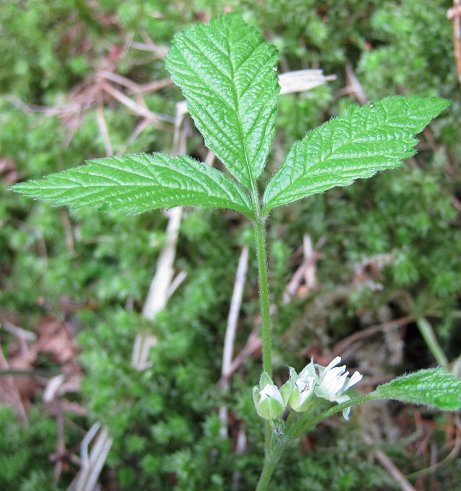 |
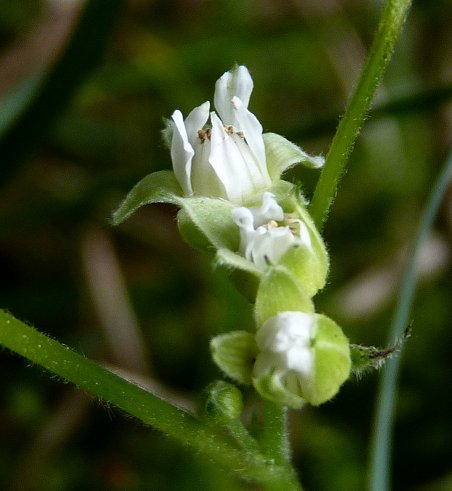 |
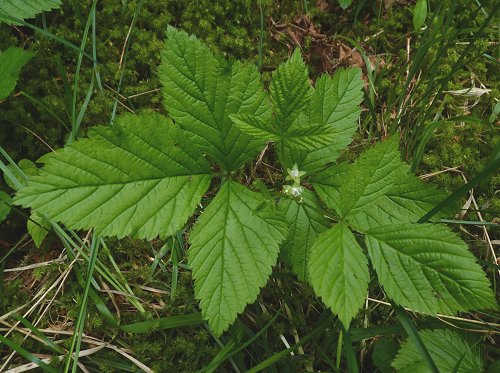 |
Three views of the stone bramble Rubus saxatilis, showing the slightly shiny, rather thin, grass-green leaves, on a plant with thin stems lacking spines and growing no more than a foot tall; the few-flowered inflorescence; and a detail of the characterstic flowers with upright, narrow petals that never open right back. |
The party stopped for lunch in the meadow, surrounded by buttercups and other flowers. Across the river we could see the heronry with at least one bird perched in the trees, probably on a nest. There are apparently fewer nests this year, perhaps down to three. After lunch most of the party took the sensible route along the bottom of the woods to Sleightholmedale Lodge, but the more adventurous took the “ Four Bridges Trail” This involved crossing the river four times on bridges made from large tree-trunks by a local craftsman; the first of them is like something out of an adventure playgound, with several separate sections suspended from chains and swinging as you walk across them – pleasantly scary! (This part of the walk is private, not on the public footpath; thanks to Rosanna for allowing us to use it.)
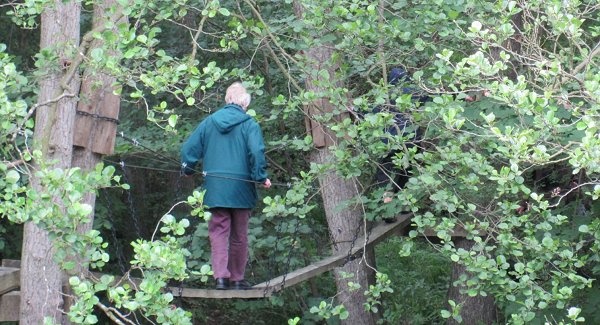
We spotted nest boxes on some of the riverside trees and were delighted to hear that one pair of pied flycatchers have successfully nested this year. The meadows along the river contain an interesting variety of plants including pignut, speedwells and perhaps more surprisingly great burnet, as well as this magnificent oak tree which must be many hundreds of years old – spot the person for scale!
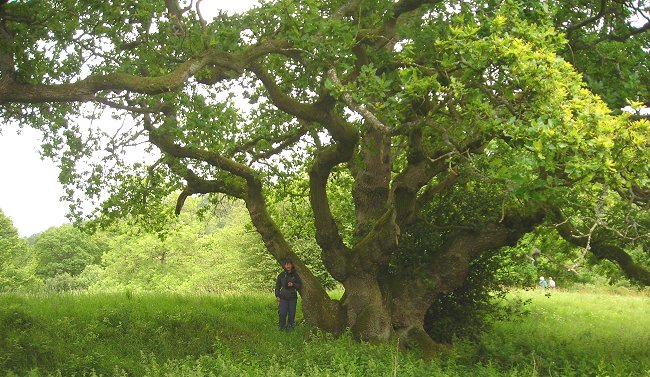
The group met up again in Rosanna’s fantastic garden. Sadly at this point the weather broke and we had to shelter from a cold shower in a summerhouse. We had an interesting discussion on gardening, including such questions as why you couldn’t re-plant the same species in the same place once the first generation had died: this is well known as a problem with roses, but it also applies to e.g. cherries or apples. Rosanna discovered this the hard way when some of the older trees in what had been a cherry avenue began to die. When the rain more or less stopped we were shown some of the new experimental areas where garden plants are encouraged to grow in native grassland (which is thus low maintenance as it only needs chopping down once a year). This seems to be very successful, especially in the area where beautiful yellow Pyrenean lilies are thriving, and another area which has species gladioli and various large-flowered cranesbills. Finally we saw the damage caused by the two or three severe May frosts we had this year, although many plants are already bouncing back.
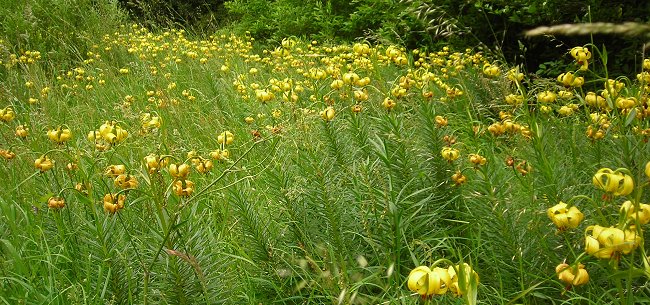
The gardens at Sleightholmedale Lodge are sometimes open to the public, and if you get the chance I would strongly recommend a visit. Even the best kept gardens sometimes suffer from pests, and we spotted one mullein plant with a serious caterpillar problem! These (see below right) are the larvae of the mullein moth Cucullia verbasci. Tom thanked Rosanna (and Poppy the dog) on our behalf for showing us round this very special corner of Ryedale, both “in the wild” and in her beautiful garden.
Species lists
I recorded 130 plants on the day, and added a few species later (thanks to Bill Thompson for identifying the Hawkweeds). Birds and other species are listed below.
| Latin name | English name |
|---|
| Acer campestre | Field maple |
| Acer pseudoplatanus | Sycamore |
| Aegopodium podagraria | Ground elder |
| Ajuga reptans | Bugle |
| Alchemilla xanthochlora | Lady's mantle |
| Alliaria petiolata | Hedge garlic or Garlic mustard |
| Allium ursinum | Ramsons |
| Alnus glutinosa | Alder |
| Anemone nemorosa | Wood anemone |
| Anthoxanthum odoratum | Sweet vernal grass |
| Aquilegia vulgaris | Columbine |
| Arctium minus | Burdock |
| Arrhenatherum elatius | False oat |
| Athyrium filix-femina | Lady fern |
| Bellis perennis | Daisy |
| Betula sp. | Birch |
| Carex flacca | Glaucous sedge |
| Carex panicea | Carnation sedge |
| Carex sylvatica | Wood sedge |
| Circaea lutetiana | Enchanterís nightshade |
| Cirsium arvense | Creeping thistle |
| Cirsium palustre | Marsh thistle |
| Cirsium vulgare | Spear thistle |
| Claytonia sibirica | Pink purslane |
| Conopodium majus | Pignut |
| Convallaria majalis | Lily of the valley |
| Cornus sanguinea | Dogwood |
| Crepis paludosa | Marsh hawksbeard |
| Cruciata laevipes | Crosswort |
| Cynosurus cristatus | Crested dogstail |
| Cytisus scoparius | Broom |
| Dactylis glomerata | Cocksfoot |
| Deschampsia caespitosa | Tufted hair grass |
| Dryopteris dilatata | Common buckler fern |
| Dryopteris filix-mas | Male fern |
| Epilobium montanum | Broad-leaved willowherb |
| Fagus sylvatica | Beech |
| Festuca rubra | Red fescue |
| Fragaria vesca | Wild strawberry |
| Fraxinus excelsior | Ash |
| Galium aparine | Cleavers |
| Galium odoratum | Woodruff |
| Geranium robertianum | Herb Robert |
| Geum rivale | Water avens |
| Geum urbanum | Wood avens |
| Hedera helix | Ivy |
| Hieracium species | Hawkweed** |
| Holcus lanatus | Yorkshire fog |
| Hyacinthoides non-scripta | Bluebell |
| Hypericum hirsutum | Hairy St Johnswort |
| Hypericum pulchrum | Beautiful St Johnswort |
| Hypochaeris radicata | Catsear |
| Ilex aquifolium | Holly |
| Lapsana communis | Nipplewort |
| Lathrea squamaria | Toothwort |
| Lathyrus linifolius | Vetch |
| Leucanthemum vulgare | Dog daisy or Ox-eye daisy |
| Listera ovata = Neottia ovata | Twayblade |
| Lolium perenne | Perennial rye grass |
| Lonicera periclymenum | Honeysuckle |
| Lotus corniculatus | Common birdsfoot trefoil |
| Luzula campestris | Field woodrush |
| Luzula pilosa | Hairy woodrush |
| Luzula sylvatica | Greater woodrush |
| Lysimachia nemorum | Yellow pimpernel |
| Matricaria discoidea | Pineapple weed |
| Melica uniflora | Wood melick |
| Mercurialis perennis | Dog's mercury |
| Mycelis muralis | Wall lettuce |
| Myrrhis odorata | Sweet cicely |
| Ophrys insectifera | Fly orchid |
| Oxalis acetosella | Wood sorrel |
| Paris quadrifolia | Herb Paris |
| Pilosella officinarum | Mouse-ear hawkweed |
| Pinus sylvestris | Scots pine |
| Plantago lanceolata | Ribwort plantain |
| Plantago major | Ratstail plantain |
| Poa trivialis | Rough meadow grass |
| Polystichum aculeatum | Hard shield fern |
| Potentilla anserina | Silverweed |
| Potentilla erecta | Tormentil |
| Potentilla reptans | Creeping cinquefoil |
| Primula veris | Cowslip |
| Primula vulgaris | Primrose |
| Primula × polyantha | False oxlip |
| Prunus spinosa | Blackthorn |
| Pteridium aquilinum | Bracken |
| Quercus sp. | Oak |
| Ranunculus acris | Meadow buttercup |
| Ranunculus repens | Creeping buttercup |
| Rhinanthus minor | Yellow rattle |
| Ribes uva-crispa | Gooseberry |
| Rosa canina | Dog rose |
| Rosa mollis | Downy rose |
| Rubus caesius | Dewberry |
| Rubus fruticosus | Bramble |
| Rubus idaeus | Raspberry |
| Rubus saxatilis | Stone bramble |
| Rumex acetosa | Common sorrel |
| Rumex obtusifolius | Broad-leaved dock |
| Sagina procumbens | Mossy or procumbent pearlwort |
| Sanguisorba officinalis | Greater burnet |
| Sanicula europaea | Sanicle |
| Silene dioica | Red campion |
| Sinapis arvensis | Charlock |
| Sorbus aucuparia | Rowan |
| Stachys officinalis = Betonica officinalis | Betony |
| Stachys sylvatica | Hedge woundwort |
| Stellaria graminea | Lesser stitchwort |
| Stellaria holostea | Greater stitchwort |
| Succisa pratensis | Devilsbit scabious |
| Tamus communis | Black bryony |
| Taraxacum sp. | Dandelion |
| Tilia cordata | Small-leaved lime |
| Trifolium dubium | Lesser trefoil |
| Trifolium medium | Zigzag clover |
| Trifolium pratense | Red clover |
| Trifolium repens | White clover |
| Tussilago farfara | Coltsfoot |
| Ulex europaeus | Gorse |
| Ulmus glabra | Wych elm |
| Urtica dioica | Nettle |
| Vaccinium myrtillus | Bilberry |
| Veronica beccabunga | Brooklime |
| Veronica chamaedrys | Germander speedwell |
| Veronica montana | Wood speedwell |
| Veronica officinalis | Heath speedwell |
| Viburnum opulus | Guelder rose |
| Vicia sepium | Bush vetch |
| Viola riviniana | Dog violet |
List created with “PlantFinder”.
|
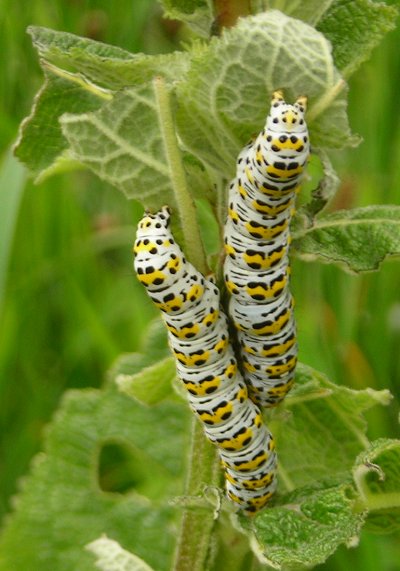
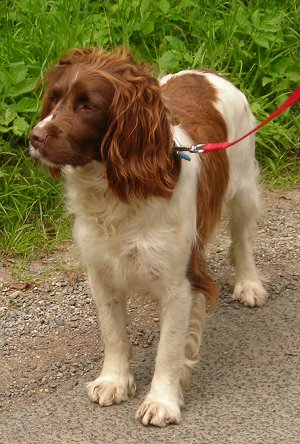
|
** Bill Thompson identified Hieracium pellucidum (good colony), H. argillaceum (few), H. sabaudum (few), H. consociatum (singleton) and
H. vulgatum (singleton) all along the same short stretch of wooded track.
On an earlier visit in May we also saw Yellow archangel Lamiastrum galeobdolon, Early purple orchid Orchis mascula and spindle Euonymus europaeus (and the bluebells were fully out). This is an impressive list with almost 140 species, and I’m sure I will have missed some. There was also one plant of the alien American skunk cabbage Lysichiton americanus on the west bank of the river which has presumably washed down from the old ornamental gardens at the top of Bransdale. This is a potentially invasive plant and should be monitored carefully.
Birds
Probably because of the time of year we didn’t see or hear many birds (they would be busy feeding young, and hidden in the thick foliage of the woods). Tom Denney recorded songthrush, blackbird, wren, robin, bullfinch, goldfinch, chaffinch, heron, kestrel, jackdaw and rook. Rosanna tells us that “the heronry is still there but only a few nests this year (3?). At least one pair of pied flycatcher nested down by the Hodge south of the Lodge, and a pair of spotted flycatcher nesting in the Lodge gardens.”
Other species
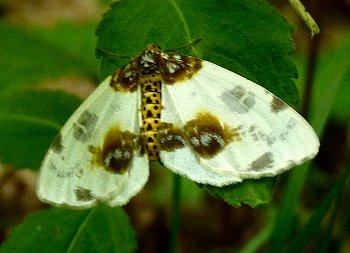 We saw one hare in the meadow, a clouded magpie (see left) and a couple of chimney sweeper moths and one or two white butterflies, but the insect count was disappointingly low.
We saw one hare in the meadow, a clouded magpie (see left) and a couple of chimney sweeper moths and one or two white butterflies, but the insect count was disappointingly low.
| Text © Ryedale Natural History Society 2010; photos © Gill Smith, Nan Sykes and Ryenats 2010 |
Back to the Home page |
 A dozen members attended this very interesting meeting in Sleightholmedale which was led by Mrs Rosanna James from Sleightholmedale Lodge. Unfortunately the weather was not kind – it was cool and windy with showers, much more like April than mid-June! We met at the end of the Avenue, walked down through the woods and then back through the meadows. Rosanna set the scene for us by explaining that when she lived here as a child she and her sister used to go exploring in the woods and fields, and became fascinated by the wealth of wildflowers growing there. This is an area of ancient woodland on steep slopes cutting through bands of limestone and some sandstone, giving a great variety of soils and therefore niches for different plants. There are several unusual plants in these woods, such as columbine and stone bramble (see detail of flower left). In the flat valley bottom is an area of old meadows that are lightly grazed by cattle, a form of management that has not changed in several hundred years. In 1986 some 80 acres of this valuable habitat was made into an SSSI, including the meadows and some of the woodland. On the west bank of the river is a heronry.
A dozen members attended this very interesting meeting in Sleightholmedale which was led by Mrs Rosanna James from Sleightholmedale Lodge. Unfortunately the weather was not kind – it was cool and windy with showers, much more like April than mid-June! We met at the end of the Avenue, walked down through the woods and then back through the meadows. Rosanna set the scene for us by explaining that when she lived here as a child she and her sister used to go exploring in the woods and fields, and became fascinated by the wealth of wildflowers growing there. This is an area of ancient woodland on steep slopes cutting through bands of limestone and some sandstone, giving a great variety of soils and therefore niches for different plants. There are several unusual plants in these woods, such as columbine and stone bramble (see detail of flower left). In the flat valley bottom is an area of old meadows that are lightly grazed by cattle, a form of management that has not changed in several hundred years. In 1986 some 80 acres of this valuable habitat was made into an SSSI, including the meadows and some of the woodland. On the west bank of the river is a heronry. Along the track there are numerous wild roses, including this – one of the Rosa mollis group, with deep pink flowers, bluish foliage, thin straight prickles and numerous glandular hairs on the sepals. Just by the gate from the meadow back into the woods there is a run of fine old lime trees (the native species Tilia cordata with relatively delicate foliage and the flower clusters held above the leaves). Along this stretch of path Rosanna remembers there used to be a few plants of wintergreen Pyrola minor. Several of us searched the woods quite thoroughly but sadly failed to find it. Pauline is familiar with this species and reckons it would be easier to spot in late autumn or winter when other plants have died down – as its name suggests Pyrola remains green and therefore stands out against the brown of dead leaves – so it is probably worth another search later in the year. It would certainly be great to find this unusual plant still growing here on one of its known old sites. We did find both columbine and lily of the valley (leaves only, the flowers had finished), but the highlight for many of us was a good colony of stone bramble. This is a small relative of blackberries and raspberries that grows on steep rocky slopes, in or near old woods, at least here in Ryedale. It is difficult to identify unless it is in flower or fruit: here you can see the characteristic flowers with small, narrow, pure white petals standing upright from the five sepals that open out into a 5-pointed star as the flowers fade. The fruits, which don’t form very often, are red and shiny, with fewer segments than a bramble.
Along the track there are numerous wild roses, including this – one of the Rosa mollis group, with deep pink flowers, bluish foliage, thin straight prickles and numerous glandular hairs on the sepals. Just by the gate from the meadow back into the woods there is a run of fine old lime trees (the native species Tilia cordata with relatively delicate foliage and the flower clusters held above the leaves). Along this stretch of path Rosanna remembers there used to be a few plants of wintergreen Pyrola minor. Several of us searched the woods quite thoroughly but sadly failed to find it. Pauline is familiar with this species and reckons it would be easier to spot in late autumn or winter when other plants have died down – as its name suggests Pyrola remains green and therefore stands out against the brown of dead leaves – so it is probably worth another search later in the year. It would certainly be great to find this unusual plant still growing here on one of its known old sites. We did find both columbine and lily of the valley (leaves only, the flowers had finished), but the highlight for many of us was a good colony of stone bramble. This is a small relative of blackberries and raspberries that grows on steep rocky slopes, in or near old woods, at least here in Ryedale. It is difficult to identify unless it is in flower or fruit: here you can see the characteristic flowers with small, narrow, pure white petals standing upright from the five sepals that open out into a 5-pointed star as the flowers fade. The fruits, which don’t form very often, are red and shiny, with fewer segments than a bramble.







 We saw one hare in the meadow, a clouded magpie (see left) and a couple of chimney sweeper moths and one or two white butterflies, but the insect count was disappointingly low.
We saw one hare in the meadow, a clouded magpie (see left) and a couple of chimney sweeper moths and one or two white butterflies, but the insect count was disappointingly low.